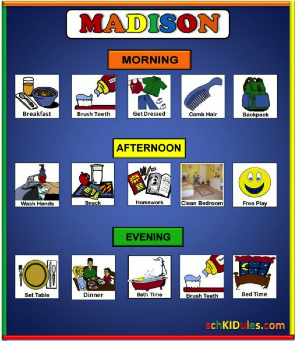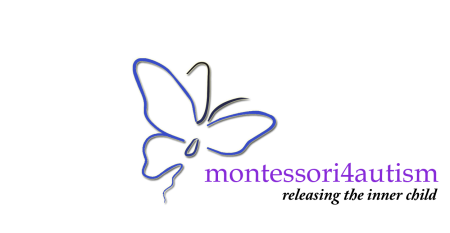Materials and Visual Schedules
Materials
Classroom materials
Montessori materials – colorful, self-correcting and rich in content – are typically appealing to children with ASDavid However, you should be prepared for the materials to be sometimes handled more intensely and get mouthed, etc. Expect the Pink Tower (one of the most popular Montessori material used to teach size, sequencing, math, coordinated movement, etc.) to be possibly destroyed after or before it is built. It is not well known, but Maria Montessori actually intended the tower to be knocked over when it was finished being built. You will need to take care that small pieces of equipment, such as the Golden Beads (widely used to teach mathematical concepts), do not get choked upon.
Visual Schedules
Children with autism generally participate more actively and fully in their school day with the assistance of visual schedules and prompts, which should be part of the classroom accommodations for ASD students. Benefits of visual schedules for both typical children and those with special needs have been demonstrated in numerous studies (e.g., Mesibov, et al, 2002; Massey & Wheeler, 2000; Bryan & Gast, 2000) and supported by a wealth of anecdotal evidence.
A visual schedule is the display of a planned activity or sequence in pictures, ordered in the way the activity or sequence is to take place. A visual schedule helps children:
- Understand what is about to take place.
- Anticipate what will come next, and ensure smooth transitioning between activities.
- Visualize and then participate in the activity displayed on the schedule.
- Prevent anxiety associated with unexpected changes to the routines.
- Break down activities and tasks into more manageable smaller steps.
- Understand sequencing and passage of time.

For various books and products on visual schedules click here
For products related to other visual supports click here
Click here to download a few examples of pictorial classroom routines, school subjects, classroom jobs, etc.
Making a visual schedule. Materials you will need are a printer, paper, scissors, foam board, Velcro, and a laminator.
- Attach a strip of Velcro to a foam board
- Print cards on a sheet of paper
- Laminate this sheet, and then cut out the individual pictures (or laminate each picture in a separate laminate pocket)
- Attach a small strip of Velcro to the back of each picture so that they will stick to the schedule strip on the foam board.
Child participation. Once a schedule is prepared, it is important to use the schedule consistently and make it part of the child’s daily routine. At the beginning, the teacher or parent should model how to use it and then engage the child in the process.
For a schedule to be most beneficial, it is important to have some way of indicating that an activity has ended. This can be done by either turning the picture over, or placing it in a “finished” pocket or container. A Guide (teacher) can use a visual schedule for the whole class to foster planning and sequencing skills. This schedule can be created by placing each child’s name at the top of a foam board and attaching a strip of Velcro under each name.
The Guide can recommend or choose core activities (for example, math, word study and geography) and post them under a child’s name. Children can then add their own activity choices (botany, history, and music) as part of their daily planning. As the children complete each task, they remove the corresponding card and deposit it in a “finished” container (or Ziploc bag) at the bottom of the board. One option is to illustrate the schedule with photos or drawings of relevant materials, which can be clipped out of old Montessori catalogues.
